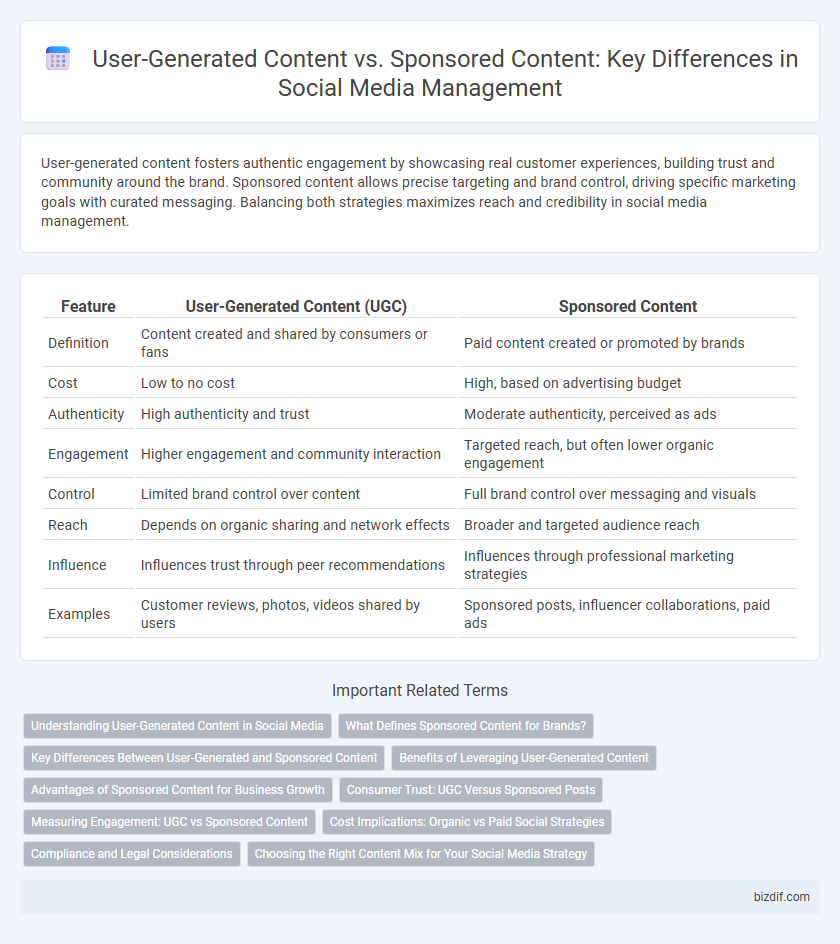User-generated content fosters authentic engagement by showcasing real customer experiences, building trust and community around the brand. Sponsored content allows precise targeting and brand control, driving specific marketing goals with curated messaging. Balancing both strategies maximizes reach and credibility in social media management.
Table of Comparison
| Feature | User-Generated Content (UGC) | Sponsored Content |
|---|---|---|
| Definition | Content created and shared by consumers or fans | Paid content created or promoted by brands |
| Cost | Low to no cost | High, based on advertising budget |
| Authenticity | High authenticity and trust | Moderate authenticity, perceived as ads |
| Engagement | Higher engagement and community interaction | Targeted reach, but often lower organic engagement |
| Control | Limited brand control over content | Full brand control over messaging and visuals |
| Reach | Depends on organic sharing and network effects | Broader and targeted audience reach |
| Influence | Influences trust through peer recommendations | Influences through professional marketing strategies |
| Examples | Customer reviews, photos, videos shared by users | Sponsored posts, influencer collaborations, paid ads |
Understanding User-Generated Content in Social Media
User-generated content (UGC) in social media refers to authentic posts, reviews, photos, and videos created voluntarily by consumers rather than brands. It enhances engagement and trust by showcasing real experiences and opinions, making it a powerful tool for organic brand promotion. Analyzing UGC helps marketers leverage community-driven insights to shape content strategies and boost social proof.
What Defines Sponsored Content for Brands?
Sponsored content for brands is defined by paid collaborations where companies compensate influencers or creators to promote products or services, ensuring clear disclosure to maintain transparency. This content is strategically crafted to align with brand messaging while leveraging the influencer's audience reach and trust. Unlike user-generated content, sponsored posts have a deliberate marketing objective, controlled creative direction, and contractual agreements.
Key Differences Between User-Generated and Sponsored Content
User-generated content (UGC) originates from customers or fans, reflecting authentic experiences and fostering community trust, while sponsored content is professionally produced and paid for by brands to promote products or services. UGC leverages organic engagement and higher perceived credibility, whereas sponsored content offers controlled messaging and strategic targeting. Metrics for UGC focus on engagement rates and brand advocacy, contrasting with sponsored content's emphasis on reach, conversions, and ROI tracking.
Benefits of Leveraging User-Generated Content
User-generated content (UGC) enhances brand authenticity by showcasing real customer experiences, leading to increased trust and engagement on social media platforms. This type of content often results in higher conversion rates because it resonates more deeply with potential customers compared to sponsored content. Leveraging UGC also reduces content creation costs while fostering a community-driven brand presence that boosts organic reach and loyalty.
Advantages of Sponsored Content for Business Growth
Sponsored content offers businesses precise targeting capabilities, enabling brands to reach specific audience segments with tailored messaging that drives higher engagement rates. This form of advertising ensures consistent brand voice and quality control, enhancing credibility and fostering stronger consumer trust. By leveraging sponsored content, companies can accelerate lead generation and revenue growth through increased visibility and strategic placement within relevant digital channels.
Consumer Trust: UGC Versus Sponsored Posts
User-generated content (UGC) significantly enhances consumer trust by showcasing authentic experiences and peer endorsements that resonate more deeply with audiences. Sponsored content, while professionally crafted and brand-aligned, often lacks the genuine appeal that drives higher engagement and credibility. Studies indicate consumers are 2.4 times more likely to trust UGC over traditional branded posts, making it a crucial strategy in social media management for building brand loyalty.
Measuring Engagement: UGC vs Sponsored Content
User-generated content (UGC) typically drives higher engagement rates due to its authenticity and relatability, resulting in increased likes, comments, and shares compared to sponsored content. Sponsored content often achieves targeted reach through paid promotion but may experience lower organic interaction because audiences perceive it as less trustworthy. Measuring engagement involves analyzing metrics like engagement rate, click-through rate, and sentiment to assess the effectiveness of UGC versus sponsored campaigns.
Cost Implications: Organic vs Paid Social Strategies
User-generated content (UGC) significantly reduces social media management costs by leveraging authentic content created by customers, eliminating expenses related to content production and influencer fees. Sponsored content, while requiring higher investment due to paid promotions and creative development, enables precise targeting and faster audience reach, making it suitable for campaigns with specific conversion goals. Balancing UGC's organic reach with sponsored content's paid amplification optimizes overall budget efficiency and maximizes return on investment (ROI) in social media strategies.
Compliance and Legal Considerations
User-generated content (UGC) requires thorough compliance checks to ensure adherence to intellectual property rights and privacy laws, as brands must secure explicit permissions from creators before usage. Sponsored content demands clear disclosure in accordance with FTC guidelines to prevent deceptive advertising practices and maintain transparency with audiences. Both content types necessitate meticulous contract management and regular audits to mitigate legal risks and safeguard brand reputation.
Choosing the Right Content Mix for Your Social Media Strategy
User-generated content (UGC) builds authentic brand trust by showcasing real customer experiences, which boosts engagement rates by up to 28%. Sponsored content delivers precise audience targeting and scalable reach, generating higher conversion rates through tailored advertising campaigns. Balancing UGC for authenticity with sponsored content for controlled messaging creates an optimized social media strategy that enhances brand credibility and drives measurable ROI.
User-generated content vs Sponsored content Infographic

 bizdif.com
bizdif.com